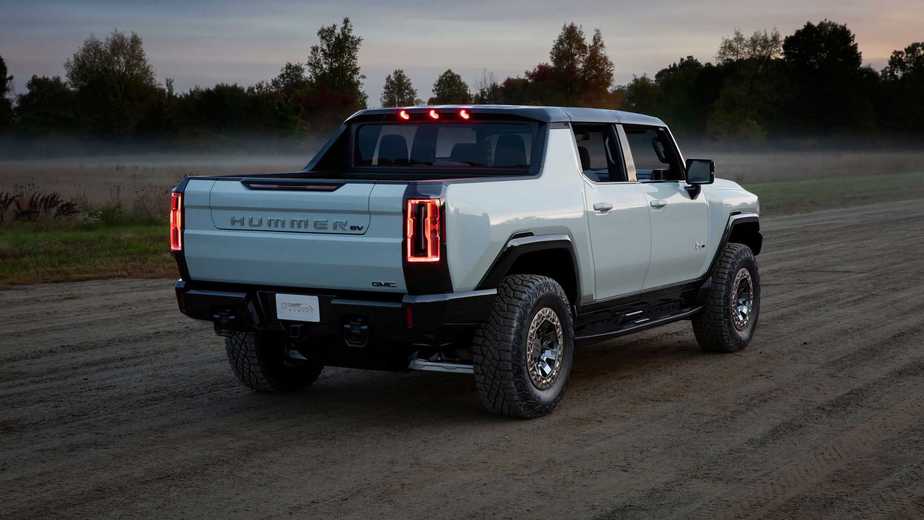The original Hummer was a beast of a truck. But, the electric Hummer is a whole new level of awesome, all thanks to some seriously cool tech.
It blows my mind that we have an electric Hummer nowadays, considering that not too long ago, these bad boys were infamous gas-guzzling, pollution-spewing monsters.
Take the H1 Hummer, for example. It only gets 10 miles per gallon of gas and tips the scales at a whopping 8,000 pounds. In contrast, a Ford F-150 truck weighs a mere 4,000 to 5,000 pounds.
Now, let’s talk about the Hummer EV. I wanna dig into the electrifying engineering behind some of its components. Yeah, the Hummer EV still resembles a brick and isn’t aerodynamically sleek, but you can’t ignore the insane power GM has packed into this ride. With cutting-edge battery tech, the Hummer EV has transformed into an eco-friendly beast of a machine.
So, can the Hummer EV really reinvent itself and rock a new image? Let’s see what it’s got by diving into some thrilling topics:
- Power specifications
- Charging costs
- Driving range
- Charging speeds
Hummer EV power specs

The electric Hummer boasts an e4WD system juiced up by three electric motors—one up front and two in the back. Each motor has a 250 kW rating, pushing this beast to a max power output of 750 kW, or around 1,000 horsepower!
Now, hold your horses (pun intended) because that peak 1,000 HP isn’t something you can use all the time. It’s only available for short, exhilarating bursts when you engage the “Watts to Freedom” mode. So, if you’re itching to go from 0 to 60 mph in an insane 3 seconds, that’s when you’ll really feel the power!
But what really grabs my attention is the Hummer’s battery setup.
The battery system calculation
You might be wondering: how does something as massive as a Hummer glide so smoothly? The secret sauce? A ginormous battery, of course!
Let’s get up close and personal with the Hummer’s battery system. The Hummer EV houses a total of 576 cells, figured out by multiplying 24 cells by 24 modules. Each battery cell packs about 100 Amp-hours, meaning the whole battery system’s got a capacity of 57,600 Amp-hours (Ah).
Now, don’t forget that Amp-hours multiplied by Volts equals Watt-hours (Wh). We’re just using the P = VI formula here, where P is power measured in watts. For reference, 1,000 Watts equals 1 kilowatt (kW), and we measure battery energy storage in kWh.
Assuming the nominal voltage of a lithium-ion battery is 3.60 volts per cell, the math goes like this: 57,600 Ah x 3.6 volts = 207,360 Wh or a stunning 207.4 kWh!
To give you an idea of how massive a battery pack rating of over 200 kWh is, here’s a comparison with other EVs:
| Electric vehicle | Battery usable | Range | Fully charge cost | Cost per mile |
|---|---|---|---|---|
| Hummer EV (tri motor) | 207.4 kWh | 350 miles | $32.66 | $0.093 |
| Cybertruck (tri motor) | 200 kWh | 500 miles | $31.49 | $0.063 |
| Model 3 (Long Range) | 82 kWh | 353 miles | $12.91 | $0.037 |
| Model S (Long Range) | 90 kWh | 412 miles | $14.17 | $0.034 |
| Model X (Long Range) | 90 kWh | 360 miles | $14.17 | $0.039 |
| Model Y (Long Range) | 72.5 kWh | 326 miles | $11.42 | $0.035 |

Important Note: GM rigged up 12 battery modules, creating a 400-volt battery pack. Then, they hooked up two 400-volt packs in parallel, adding up to 24 battery modules in total.
Hummer EV charging cost
Charging an electric vehicle’s cost hinges on the type of charger you plug into. So let’s stack Level 2 and Level 3 chargers against each other.
First up, let’s roll with an average electricity rate of 13.7 cents per kWh from February 2021. We’ll use this rate to figure out the cost of fully charging the Hummer EV at home, assuming a charger efficiency of 0.87.
(207.4 kWh / 0.87) x \$0.137 per kWh = \$32.66
Next, Tesla’s Supercharger runs about \$0.26 per kWh. So we can safely bet that the cost to juice up the Hummer EV on any other DC Fast charger would be in the same ballpark.
(207.4 kWh / 0.87) x \$0.26 per kWh = \$61.98
To put these costs into perspective, let’s see how they measure up to the expense of fueling a gas-thirsty Hummer.
| Vehicle | Charger/Fuel type | Batter/Tanks size | Cost of fuel (2021) | Full fueling cost | Cost/mile |
|---|---|---|---|---|---|
| Hummer EV (350 mile range) | Level 2 charger | 207.4 kWh | $0.137/kWh | $32.66 | $0.09/mile |
| Hummer EV (350 mile range) | Level 3 charger | 207.4 kWh | $0.26/kWh | $61.98 | $0.18/mile |
| Hummer H1 (250 mile range) | Diesel | 25 gallons | $3.249/gallon | $81.23 | $0.32/mile |
| Hummer H2 (320 mile range) | Premium gasoline | 32 gallons | $3.028/gallon | $96.90 | $0.30/mile |
| Hummer H3 (322 mile range) | Premium gasoline | 23 gallons | $3.028/gallon | $69.64 | $0.22/mile |
As you can see, driving an electric Hummer instead of the old gas-guzzlers can save you a pretty penny. But remember that the electric Hummer’s purchase price may eat into those savings over time.
Breakeven cost comparison between a Hummer EV and Hummer H3
The “Edition 1” Hummer EV truck slaps a price tag of about \$106,000, while a solid used 2006 H3 Hummer with 20,000 miles goes for roughly \$25,000. That’s a jaw-dropping cost difference of \$81,000!
Now let’s say you drive 13,500 miles a year, which is the average number of miles driven per year in the U.S., according to the Department of Transportation.
Time for some math.
Hummer EV: 13,500 miles x \$0.09 = \$1,215 per year
Hummer H3: 13,500 miles x \$0.22 = \$2,970 per year
So, the annual cost gap between the Hummer H3 and EV comes to around \$1,755. But to break even on the upfront cost difference of \$81,000, it would take a staggering \$81,000 / \$1,755 = 46 years!
Of course, there’ll be other maintenance costs tied to a used H3 Hummer. However, the main takeaway is that cost savings usually aren’t the main reason people would buy a Hummer EV. Most folks who spring for a Hummer EV are after a badass cool, rugged EV!
To learn more about electric vehicle charging costs, read here.
Hummer EV driving range

GM has been tossing around a driving range of 350 miles for this monstrous machine, which trumps the range of its gas-chugging ancestors like:
- H1: 250 miles
- H2: 320 miles
- H3: 322 miles
The Hummer EV has a slight advantage, but before we start comparing apples to oranges, let’s remember that the weight of these models can majorly impact the range.
Now, let’s pit the Hummer EV against other popular electric vehicles. Scope out the table below for the driving range of famous EVs, including the Tesla Cybertruck. Keep in mind that the estimated charging costs are based on using Level 2 chargers.
| Electric vehicle | Battery usable | Range | Fully charge cost | Cost per mile |
|---|---|---|---|---|
| Hummer EV (tri motor) | 207.4 kWh | 350 miles | $32.66 | $0.093 |
| Cybertruck (tri motor) | 200 kWh | 500 miles | $31.49 | $0.063 |
| Model 3 (Long Range) | 82 kWh | 353 miles | $12.91 | $0.037 |
| Model S (Long Range) | 90 kWh | 412 miles | $14.17 | $0.034 |
| Model X (Long Range) | 90 kWh | 360 miles | $14.17 | $0.039 |
| Model Y (Long Range) | 72.5 kWh | 326 miles | $11.42 | $0.035 |
It’s no shocker that the Hummer EV isn’t the most efficient ride on the list. I mean, it’s a beast of a machine and doesn’t exactly cut through the wind. It’s got a massive weight and a not-so-great drag coefficient.
But get this: If GM managed to trim the Hummer EV’s weight, they could potentially boost its driving range to nearly 500 miles! Of course, that’d mean ditching the iconic design we all know and love.
Hummer EV charging speed
We already know the Hummer’s battery design rocks two 400-volt packs connected in parallel. But what’s super rad is that you can plug it into an 800-volt charger!
This is doable because the Hummer’s internal electrical components rejig themselves, hooking up the two 400-volt battery packs in series. When batteries connect in series, their voltage stacks up, so in this case, 400V + 400V = 800V.
With an 800V DC fast charger rated at 350 kW, you can pull about 250 amps, letting you juice up your Hummer in a flash. Using the charge time formula, we can crunch these numbers:
[Latexpage]
Charge time = $\dfrac{\text{battery capacity}}{\text{charger power x 0.87}} = \dfrac{\text{207.4kWh}}{\text{350 x 0.87}}$ = 0.68 hours
That’s right, the charge time’s about 41 minutes to go from a drained battery to a full charge.
Keep in mind that the 350 kW peak power only lasts a short while, and the power naturally drops off as the battery charge goes up. You can see this charging profile in the table below, showing peak power versus charging time using data from a 250 kW DC fast charger.
| Charging Time | Peak power |
|---|---|
| 5 minutes | 245 kW |
| 15 minutes | 225 kW |
| 20 minutes | 200 KW |
| 30 minutes | 135 kW |
| 40 minutes | 85 kW |
| 50 minutes | 50 kW |
| 60 minutes | 35 kW |
Now, let’s compare the charging speed using other EV charger types.
| Charger type | Peak power | Charging time |
|---|---|---|
| Level 1, 120V-1∅ | 1.4 kW | 170.3 hours |
| Level 2, 240V-1∅ | 7.6 kW | 31.4 hours |
| Level 3, 480V-3∅ | 250 kW | 0.95 hours |
| Level 3, 800V-3∅ | 350 kW | 0.68 hours |
To get a better grip on calculating charging speed, read here.
Conclusion
Hold onto your hats, folks, because the Hummer’s back and badder than ever!
Back in the day, Hummers weren’t exactly the go-to for eco-friendliness. But the new electric Hummer’s a real game-changer. Sure, it can’t save the planet all by itself, but it’s still one impressive, powerful ride, even with its non-aerodynamic design.
The new Hummer EV’s light-years ahead of its old-school siblings, and its slick, modern look is bound to draw in a fresh crowd of people who dig big, rugged trucks but might’ve been on the fence about going electric. It’s wild to see how far we’ve come in the world of electric vehicles, and the Hummer EV stands as a testament to this engineering wonder.
What do you think about an all-electric Hummer? What blows your mind about the engineering behind the electric Hummer? What’s your take on the eco-friendliness of the electric Hummer?
Featured Image Photo Credit: Kala4i4ek (Photo Cropped)

Respectable….but slightly misleading.
You left out delivery costs of electricity. That amount can double the KWh cost.
Next, high demand costs depend on the time of day. You must watch out for that.
And then, the drive tests demonstrate only 290 miles per charge, not 350. I suspect as the batteries age, this value will become smaller.
Finally, average the cost of batteries over their expected life and add this value to the cost per mile.
What, then, is the cost per KWh?
There isn’t enough electric generation capacity in the US for conversion to electric vehicles…at present.
What is the cost of acquiring and disposing of raw materials needed to build batteries? It’s NOT free.
There is no free lunch!!!
Great points, Paul!
The power infrastructure (e.g. equipment maintenance and upgrades) cost of the utility is baked into the energy rate (i.e. the costs are passed onto the customer through their energy bills) – this includes the power transmission and distribution you reference.
Yes, the time of day is critical. It’s why I used an average electricity rate to simplify the calculation.
I was unaware the tests demonstrated 290 miles per charge – seems to be new test data, after I wrote this article in 2021…
As for the average cost of batteries, this is a valid point. It becomes a slippery slope to then compare batteries to all the moving parts in the ICE counterpart. Would require a deeper analysis, with greater data, which I don’t have.
Much of the R&D and acquiring and disposing of the battery costs will be baked into the total vehicle cost. This cost may trend up depending on the mass adoption of EVs and battery technology, as you alluded to.
Once I have more data, I’ll update the article.
And you’re right; currently as designed, our grid does not have the capacity to feed uniform adoption of EVs across the entire population.